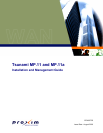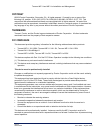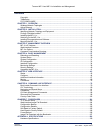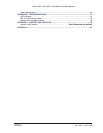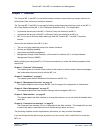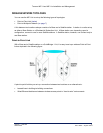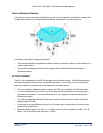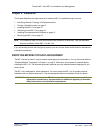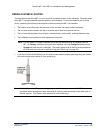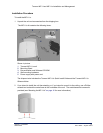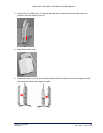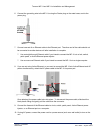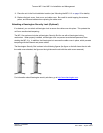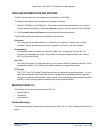
Tsunami MP.11and MP.11a Installation and Management
COPYRIGHT
©2003 Proxim Corporation, Sunnyvale, CA. All rights reserved. Covered by one or more of the
following U.S. patents: 5,231,634; 5,875,179; 6,006,090; 5,809,060; 6,075,812; 5,077,753. This
manual and the software described herein are copyrighted with all rights reserved. No part of this
publications may be reproduced, transmitted, transcribed, stored in a retrieval system, or translated into
any language in any form by any means without the written permission of Proxim Corporation.
TRADEMARKS
Tsunami, Proxim, and the Proxim logo are trademarks of Proxim Corporation. All other trademarks
mentioned herein are the property of their respective owners.
FCC COMPLIANCE
This document provides regulatory information for the following wireless base station products:
▪ Tsunami MP.11 2411 BSU, Tsunami MP.11 2411 SU, Tsunami MP.11 2411 RSU
▪ Tsunami 2411 QuickBridge 11
▪ Tsunami MP.11a BSU, Tsunami MP.11a SU, Tsunami MP.11a RSU
This device complies with Part 15 of the FCC Rules. Operation is subject to the following two conditions:
(1) This device may not cause harmful interference
(2) This device must accept any interference received, including interference that may cause undesired
operation.
This device must be professionally installed.
Changes or modifications not expressly approved by Proxim Corporation could void the user's authority
to operate the equipment.
This equipment has been tested and found to comply with the limits for a Class B digital device,
pursuant to Part 15 of the FCC Rules. These limits are designed to provide reasonable protection
against harmful interference in a residential installation.
This equipment generates, uses, and can radiate radio frequency energy and, if not installed and used
in accordance with the instructions, may cause harmful interference to radio communications. However,
there is no guarantee that interference will not occur in a particular installation. If this equipment does
cause harmful interference to radio or television reception (which can be determined by turning the
equipment off and on), the user is encouraged to attempt to correct the interference by one or more of
the following measures:
▪ Reorient or relocate the receiving antenna.
▪ Increase the separation between the equipment and receiver.
▪ Connect the equipment into an outlet on a circuit different from that to which the receiver is
connected.
▪ Consult the dealer or an experienced radio or television technician for help.
This device must be professionally installed. Antennas used for the MP.11a product must be fix-
mounted on permanent structures with a separation distance of at least 2 meters from all persons during
normal operation.
Notices 2
CPN 65755 Issue Date: August 2003



